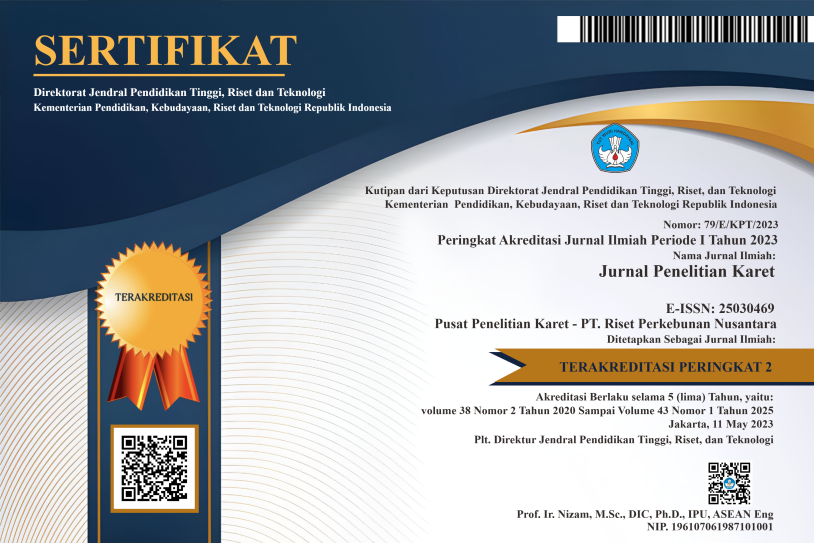IMPROVEMENT OF PHYSIOLOGICAL CONDITION AND LATEX FLOW OF RUBBER CLONES AFFECTED BY TAPPING PANEL DRYNESS IN RESPONSE TO COMBINATION NAPHTHALENE ACETIC ACID, ASCORBIC ACID, AND NUTRITION TREATMENTS
DOI:
https://doi.org/10.22302/ppk.jpk.v39i2.800Keywords:
anti-oxidance enzyme, Hevea brasiliensis, latex production, tapping panel drynessAbstract
The TPD incident is one of the factors causing rubber estates to lose their production. The objective of this research was to arrange formulation for recovering of tapping panel dryness (TPD) chases, especially on PB 260 and IRR 42 clones. The experiment was divided into two experiments, that were arranged into a split plot design with two treatment factors, first the main plots of rubber plant clones (PB 260 and IRR 42), and second different NAA concentrations in the step 1. The best combination of the first experiment was added with different concentrations of ascorbic acid in the research experiment II. The physiological variables observed were sucrose, inorganic phosphate, thiol, latex production, and biochemical variables were SOD, APX, and POD enzyme activities. The TPD-affected plant could produce latex under treatment of NAA and nutrient for six months NAA 10 ppm treatment significantly affected on Pi content and had positive effect on latex production. Treatment of ascorbic acid also increased production in rubber plants and affected on POD and SOD activities. There were differences respond between high metabolism clone PB 260 and low metabolism clone IRR 42 to combination of NAA, nutrient, and ascorbic acid treatment.
References
Andrianto, M., & Tistama, R. (2014). Progress and efforts to overcome tapping panel dryness on rubber trees (Hevea brasiliensis). Warta Perkaretan, 33(2): 89-102.
Bradford, M. M. (1976). A rapid and sensitive for the quantification of microgram quantities of protein utilizing the principle of protein-dye binding. Anal Biochem, 72: 248-254.
de Fay, & Jacob, J. L. (1989). Symptoloogical, histological and cytological aspect. In L. d’Auzac, L. Jacob, H. Chrestine (Ed.). Physiologi of Rubber Tree Latex. Boca Raton: CRC Press.
Farooq, A., Bukhari, S. A., Akram, N. A., Ashraf, M., Wijaya, L., Alvemeni, M. N., & Ahmad, P. (2020). Exogenously applied ascorbic acid-mediated changes in osmoprotection and oxidative defense system enhanced water stress tolerance in different cultivars of safflower (Carthamus tinctorious L.). Plants, 9(104): 1-15. Doi :10.3390/plants9010104.
Fukumura, H., Sato, M., Kezuka, K., & Saito, T. (2012). Effect of ascorbic acid on reactive oxygen species production in chemotherapy and hyperthermia in prostate cancer cells. The Journal of Physiological Sciences, 62(3): 251-257. Doi: 10.1007/s12576-012-0204-0s
Herlinawati, E., & Ismawanto, S. (2017). Physiological characters and production toward tapping panel dryness of PB 260. Proceedings of International Rubber Conference (pp. 801-810). Jakarta, Indonesia: Indonesian Rubber Research Institute.
Jacob, J. L., Prevot, J. C., Roussel, D., Lacrotte, R., Serres, E., d Auzac, Eschbach, & Omont, H. (1989). Yield limiting factors, latex physiological parameters, latex diagnosis, and clonal typology. In: J. d’Auzac, J. L. Jacob, C. Chrestin (Ed.). Physiology of Rubber Tree Latex. Boca Raton: CRC Press.
Joseph, M. (2006). Soil properties and nutritional status of trees in relation to tapping panel dryness syndrome in natural rubber. In J. Jacob, R. R. Krishnakumar, & N. M. Mathew. (Ed.). Tapping Panel Dryness of Rubber Trees. India: Rubber Research Institute of India.
Koryati, T., & Siregar, L. A. M. (2013). Auxin hormone analysis for clones of immature rubber plant. Proceedings of the 3rd Annual International Conference Syiah Kuala University (AIC Unsyiah) 2013 in conjunction with the 2nd International Conference on Multidisciplinary Research (ICMR) 2013 (pp. 375-379). Banda Aceh, Indonesia: Syiah Kuala University.
Koryati, T., & Tistama, R. (2020). The role of paclobutazol toward plant growth and latex physiology on some rubber clones. Indonesian J. Nat. Rubb. Res., 38(1): 49-64.
Kumari, S. A. A. A. P., & Nugawela, R. C. W. M. R. A. (2013). Harvesting of natural rubber trees (Hevea brasiliensis) affected with tapping panel dryness. J Food Agric, 6(1-2): 10-15
Leiwakabessy, F. M., Wahjudin, U. M., & Suwamo. (2003). Kesuburan Tanah. Bogor: Jurusan Tanah Fakultas Pertanian, Institut Pertanian Bogor.
Mitchell, R. N., & Contran, R. S. (2008). Cell injury, cell death, and adaptations. In: Kumar, Abas, Fausto, Mitchel (Ed.). Basic Pathology. Ed.8th. Philadelphia: Elsevier Saunders.
Murashige, T., & Skoog, F. (1962). A revised medium for rapid growth and bio-assays with tobacco tissue cultures. Physiologia Plantarum, 15: 473 – 497.
Packeer-Mohamed, V., Hashim, Y. Z. H. Y., Amid, A., Mohd Salleh, H., Yusof, F., & Mel, M. (2012). A rapid method for large sample number extraction of proteins from mammalian cells. Regenerative Res 1 (2): 49-55.
Putranto, R. A., Herlinawati, E., Rio, M., Leclercq, J., Piyatrakul, P., Gohet, E., Sanier, C., Oktavia, F., Pirrello, J., Kuswanhadi, & Montoro, P. (2015). Involvement of ethylene in the latex metabolism and tapping panel dryness of Hevea brasiliensis. Intl.J. Mol Sci, 16: 17885 -17908. Doi:10.3390/ijms160817885
Rajkumar, S., Praveen, M. R., Gajjar, D., Vasawada, A. R., Alapure, B., Patel, D., & Kapur, S. (2008). Activitas of superoxide dismutase isoenzymes in epithel cells derived from different types of age-related cataract. J. Cataract Refrat. Surg., 34: 470-474.
Salama, Z. A., El Nour, A., Fouly, M. M., & Gaafar, A. A. (2014). Ascrobic acid foliiar spray counteracting effect of salinity on growth, nutrients concentrations, photosynthesis, antioxidant activities and lipid peroxidation of bean (Phaseulus vulgaris L.) cultivars. American J. of Agric. And Biol. Sci., 9(3): 384 – 393. Doi:10.3844/ajabssp.2014.384.393.
Satrio, N., Rosmayati, Kardhinata, E. H., Tistama, R., & Fipriani, A. (2016). Effect of ascorbic acid to recovery of partial tapping panel dryness (TPD) of rubber plant in the clones of PB 260 and IRR of 42. J. Agroekoteknologi, 4(4): 2400-2406.
Shannon, M. L., Kay, E., & Lew, J. Y. (1996). Peroxidase isozyme from horseradish root. J Biochem., 9(2): 2166-2172.
Sivakumaran, S., Ghandimathi, H., Hamzah, Z., Yusof, F., Hamzah, S., & Yeang, H. Y. (2002). Physiological and nutritional aspects in relation to the spontaneous development of tapping panel dryness in clone PB 260. Journal of Rubber Research, 5(3): 135-156.
Steel, R. G. D., & Torrie, J. H. (1995). Prinsip dan Prosedur Statistik. Jakarta: PT. Gramedia Pustaka Utama.
Suer, S., Agusti, J., Sanchez, P., & Greb, T., (2011). WOX4 imparts auxin responsiveness to cambium cells in arabidopsis. The Plant Cell, 23(9): 3247-3259. Doi: 10.1105/tpc.111.087874
Taiz, L., & Zeiger. (2003). Plant Physiology. New York: The Benyaming/Cumming Publishing Company. Inc.
Tistama, R., Lubis, V., & Nurwahyuni, I. (2017). Histological and physiological changes of rubber tree (Hevea brasiliensis Muell Arg.) laticifere under exogenous jasmonic acid and naphtalene acetic acid treatments. Buletin Anatomi dan Fisiologi, 2(1): 1-10.
Tistama, R., Mawaddah, P. A. S., Fipriani, L. A., & Junaidi. (2019). Physiological status of high and low metabolism Hevea clones in the difference stage of tapping panel dryness. Journal of Biodiversitas, 20(1): 267-273.
Tiva, L. K., Lacote, R., Chan, C., Sopheaveasna, M., & Erick, G. (2016). Effect of fertilization on latex yield potential and physiological parameters of clone PB 217 in Cambodia. International Rubber Conference. Siem Reap, Cambodia: IRRDB.
Zhang, Y., Leclercq, J., & Montoro, P. (2017). Reactive oxygen species in Hevea brasiliensis latex and relevance to tapping panel dryness. Tree Physiol, 37(2): 261–269. Doi: 10.1093/treephys/tpw106.
Downloads
Published
How to Cite
Issue
Section
License
Copyright (c) 2021 Ade Fipriani Lubis, Radite Tistama

This work is licensed under a Creative Commons Attribution-ShareAlike 4.0 International License.
Submission of a original research article in Jurnal Penelitian Karet implies that the submitted  manuscript has not been published in any scientific journal (except being part of the abstract, thesis, or report). The submitted manuscript also is not under consideration for publication elsewhere. All co-authors involve in the publication of the manuscript should give their approval.
Once, the manuscript is accepted and then published in Jurnal penelitian Karet, the Author(s) keep hold the copyright and retain publishing right without restrictions.
Author(s) and Jurnal Penelitian Karet users are allowed to multiply the published manuscript. The journal users are also permissible to share the published manuscript with an acknowledgement to the Author(s). The Editorial Boards suggest that the Authors should manage patent before publishing their new inventions.
















